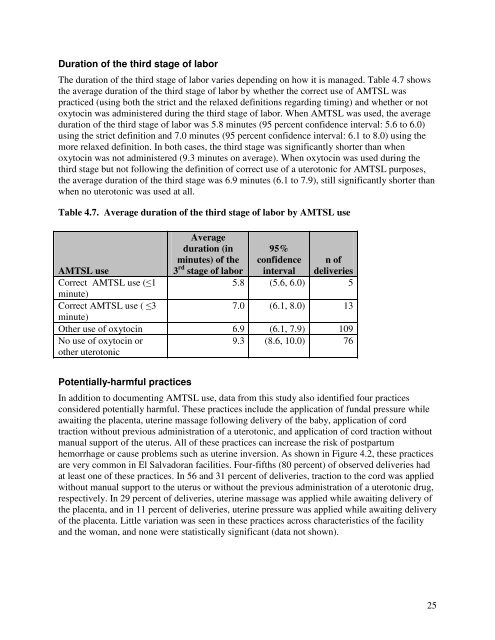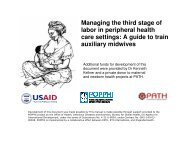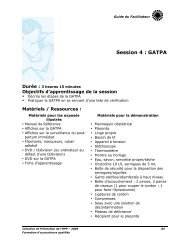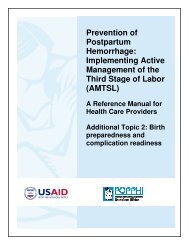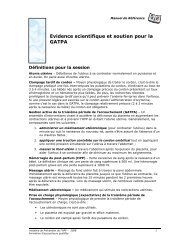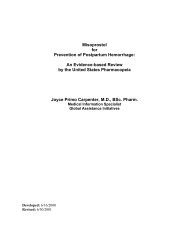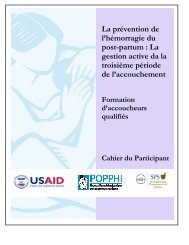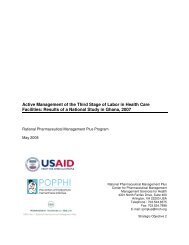El Salvador - Active Management of the Third Stage of Labor - POPPHI
El Salvador - Active Management of the Third Stage of Labor - POPPHI
El Salvador - Active Management of the Third Stage of Labor - POPPHI
You also want an ePaper? Increase the reach of your titles
YUMPU automatically turns print PDFs into web optimized ePapers that Google loves.
Duration <strong>of</strong> <strong>the</strong> third stage <strong>of</strong> laborThe duration <strong>of</strong> <strong>the</strong> third stage <strong>of</strong> labor varies depending on how it is managed. Table 4.7 shows<strong>the</strong> average duration <strong>of</strong> <strong>the</strong> third stage <strong>of</strong> labor by whe<strong>the</strong>r <strong>the</strong> correct use <strong>of</strong> AMTSL waspracticed (using both <strong>the</strong> strict and <strong>the</strong> relaxed definitions regarding timing) and whe<strong>the</strong>r or notoxytocin was administered during <strong>the</strong> third stage <strong>of</strong> labor. When AMTSL was used, <strong>the</strong> averageduration <strong>of</strong> <strong>the</strong> third stage <strong>of</strong> labor was 5.8 minutes (95 percent confidence interval: 5.6 to 6.0)using <strong>the</strong> strict definition and 7.0 minutes (95 percent confidence interval: 6.1 to 8.0) using <strong>the</strong>more relaxed definition. In both cases, <strong>the</strong> third stage was significantly shorter than whenoxytocin was not administered (9.3 minutes on average). When oxytocin was used during <strong>the</strong>third stage but not following <strong>the</strong> definition <strong>of</strong> correct use <strong>of</strong> a uterotonic for AMTSL purposes,<strong>the</strong> average duration <strong>of</strong> <strong>the</strong> third stage was 6.9 minutes (6.1 to 7.9), still significantly shorter thanwhen no uterotonic was used at all.Table 4.7. Average duration <strong>of</strong> <strong>the</strong> third stage <strong>of</strong> labor by AMTSL useAverageAMTSL useduration (inminutes) <strong>of</strong> <strong>the</strong>3 rd stage <strong>of</strong> labor95%confidenceintervaln <strong>of</strong>deliveriesCorrect AMTSL use (≤15.8 (5.6, 6.0) 5minute)Correct AMTSL use ( ≤37.0 (6.1, 8.0) 13minute)O<strong>the</strong>r use <strong>of</strong> oxytocin 6.9 (6.1, 7.9) 109No use <strong>of</strong> oxytocin oro<strong>the</strong>r uterotonic9.3 (8.6, 10.0) 76Potentially-harmful practicesIn addition to documenting AMTSL use, data from this study also identified four practicesconsidered potentially harmful. These practices include <strong>the</strong> application <strong>of</strong> fundal pressure whileawaiting <strong>the</strong> placenta, uterine massage following delivery <strong>of</strong> <strong>the</strong> baby, application <strong>of</strong> cordtraction without previous administration <strong>of</strong> a uterotonic, and application <strong>of</strong> cord traction withoutmanual support <strong>of</strong> <strong>the</strong> uterus. All <strong>of</strong> <strong>the</strong>se practices can increase <strong>the</strong> risk <strong>of</strong> postpartumhemorrhage or cause problems such as uterine inversion. As shown in Figure 4.2, <strong>the</strong>se practicesare very common in <strong>El</strong> <strong>Salvador</strong>an facilities. Four-fifths (80 percent) <strong>of</strong> observed deliveries hadat least one <strong>of</strong> <strong>the</strong>se practices. In 56 and 31 percent <strong>of</strong> deliveries, traction to <strong>the</strong> cord was appliedwithout manual support to <strong>the</strong> uterus or without <strong>the</strong> previous administration <strong>of</strong> a uterotonic drug,respectively. In 29 percent <strong>of</strong> deliveries, uterine massage was applied while awaiting delivery <strong>of</strong><strong>the</strong> placenta, and in 11 percent <strong>of</strong> deliveries, uterine pressure was applied while awaiting delivery<strong>of</strong> <strong>the</strong> placenta. Little variation was seen in <strong>the</strong>se practices across characteristics <strong>of</strong> <strong>the</strong> facilityand <strong>the</strong> woman, and none were statistically significant (data not shown).25


